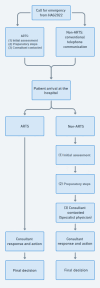Evaluating the Effectiveness of Smart Glasses in Reducing Patient Care Time in Emergency Departments: Cohort Study From the Hangzhou Asian Games
- PMID: 40587811
- PMCID: PMC12234398
- DOI: 10.2196/65617
Evaluating the Effectiveness of Smart Glasses in Reducing Patient Care Time in Emergency Departments: Cohort Study From the Hangzhou Asian Games
Abstract
Background: Challenges in emergency medicine include overcrowding, insufficient emergency care resources, and extended emergency department (ED) waiting times. These issues contribute to delays in treatment and unfavorable outcomes. This situation worsens in events with large crowds and particularly worsened during the COVID-19 pandemic. The integration of augmented reality (AR) smart glasses could potentially enhance patient care in the ED.
Objective: This study aims to assess the effectiveness of AR smart glasses in reducing patient care time in the ED during the 19th Asian Games and the Fourth Asian Para Games Hangzhou 2022 (HAG2022). The study specifically compares the prepreparation time (PPT) and consult response time (CRT) in patients receiving teleconsultations via AR smart glasses versus those receiving standard care without AR.
Methods: This retrospective study was conducted between September 13, 2023, and October 28, 2023, during HAG2022. The data were gathered from AR smart glasses using 5G technology at the HAG2022 village and electronic health records at Sir Run Run Shaw Hospital, China. The study included 2 groups: the teleconsultation by augmented reality telemedicine system (ARTS) group and the non-ARTS group. The main data assessed were PPT and CRT in ED.
Results: During the research period, 80 patients were divided into 2 cohorts: the ARTS cohort (n=10) and the non-ARTS cohort (n=70). Gender and age demographics showed no significant differences between the cohorts. The ARTS cohort had a significantly lower average PPT of 23 minutes compared to the non-ARTS cohort's 40.3 minutes (P<.001). In addition, CRT in the ARTS cohort was significantly lower at 15.6 minutes compared to the non-ARTS cohort's 164.8 minutes (P=.03). The outcomes suggest that smart glasses are effective in decreasing PPT and CRT.
Conclusions: AR smart glasses have the potential to enhance patient admission efficiency and reduce care time in EDs. However, despite these benefits, further research is needed to confirm their effectiveness, and additional studies are essential to identify the challenges and barriers to their successful implementation in emergency medicine.
Keywords: Asia; Asian Games; Chinese population; EHR; augmented reality; effectiveness; efficiency; electronic health record; emergency care; emergency medicine; multidisciplinary treatment; patient care; retrospective study; smart glasses; teleconsultation systems; telemedicine; treatment; wearable devices; wearable technology.
© Xinwei Jiang, Bangbo Xia, Mohammad Mostafa Ansari, Huiquan Jiang, Jianjiang Qi, Zhongheng Zhang, Sheng Dai, Pingping Zheng, Yang He, Ning Liu, Pengpeng Chen, Ronghua Luo, Xuchang Qin, Yansong Miao, Junru DAI, Xiaoyu Zhou, Changliang Wang, Hui Chen, Wenbin Xu, Tao Wu, Qiang Shi, Zhonghua Chen, Liping Zhou, Hao Zhang, Yun Xie, Quan Zhang, Bifa Zhou, Xiaohong Pan, Zixi Chen, Libo Zhen, Yaqing Sun, Zelin Lu, Yihao Loh, Shameera Sayer, Jennifer Mochtar, Pannika Wongpraewit, Yifan Wang, Yucai Hong. Originally published in JMIR Formative Research (https://formative.jmir.org).
Conflict of interest statement
Figures



Similar articles
-
Home treatment for mental health problems: a systematic review.Health Technol Assess. 2001;5(15):1-139. doi: 10.3310/hta5150. Health Technol Assess. 2001. PMID: 11532236
-
Physical interventions to interrupt or reduce the spread of respiratory viruses.Cochrane Database Syst Rev. 2023 Jan 30;1(1):CD006207. doi: 10.1002/14651858.CD006207.pub6. Cochrane Database Syst Rev. 2023. PMID: 36715243 Free PMC article.
-
Signs and symptoms to determine if a patient presenting in primary care or hospital outpatient settings has COVID-19.Cochrane Database Syst Rev. 2022 May 20;5(5):CD013665. doi: 10.1002/14651858.CD013665.pub3. Cochrane Database Syst Rev. 2022. PMID: 35593186 Free PMC article.
-
Intravenous magnesium sulphate and sotalol for prevention of atrial fibrillation after coronary artery bypass surgery: a systematic review and economic evaluation.Health Technol Assess. 2008 Jun;12(28):iii-iv, ix-95. doi: 10.3310/hta12280. Health Technol Assess. 2008. PMID: 18547499
-
Health Services Usage in Patients Receiving Buprenorphine for Opioid Use Disorder or Long-Term Opioid Therapy for Chronic Pain: Retrospective Cohort Study.JMIR Form Res. 2025 Jun 19;9:e66596. doi: 10.2196/66596. JMIR Form Res. 2025. PMID: 40537088 Free PMC article.
References
-
- Cheng Y, Cao X, Zhang J, Xu L, Qin L. Comprehensive assessment of emergency departments in county-level public hospitals: a multicenter descriptive cross-sectional study in Henan province, China. Front Public Health. 2023;11:1301030. doi: 10.3389/fpubh.2023.1301030. doi. Medline. - DOI - PMC - PubMed
-
- Salway R, Valenzuela R, Shoenberger J, Mallon W, Viccellio A. Emergency department (ED) overcrowding: evidence-based answers to frequently asked questions. Revista Médica Clínica Las Condes. 2017 Mar;28(2):213–219. doi: 10.1016/j.rmclc.2017.04.008. doi. - DOI
MeSH terms
LinkOut - more resources
Full Text Sources
Medical
Research Materials

